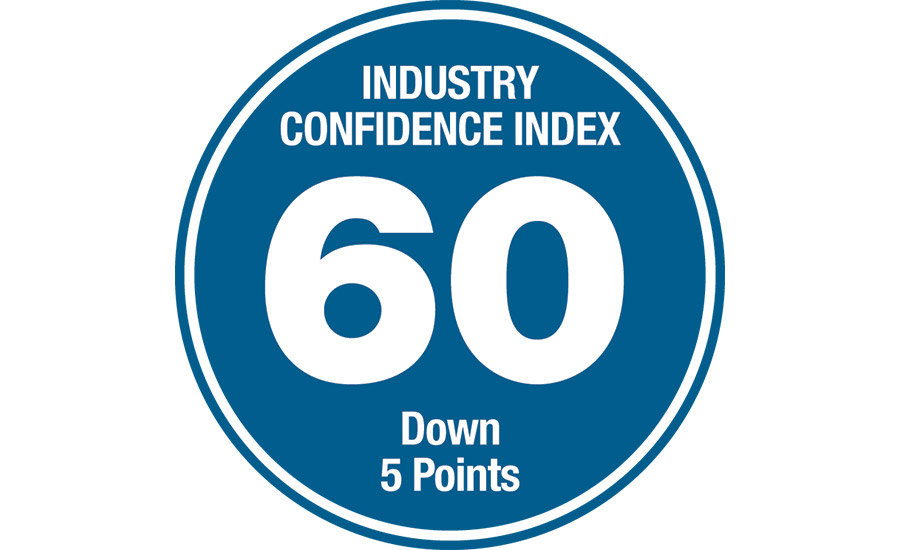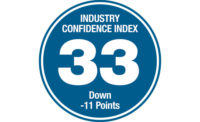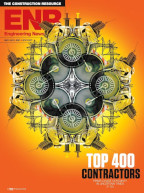The long awaited Infrastructure Investment and Jobs Act has been passed, but construction market confidence has continued to dip among industry executives.
ENR’s Construction Industry Confidence Index dropped to a rating of 60 in the fourth quarter, down five points from Q3. Confidence in the U.S. economy as a whole plunged even further, down 11 points to a feeble 50.
The law’s passage did restore some positivity among firms. Taking only those 82 firms that filed surveys on or before Nov. 5, when the House passed the bill, the index came in at a 57 rating, rising to 62 among the 100 firms who filed after. Likewise, the latter group viewed the economy much more favorably (a 54 rating) than the former (44). In all cases however, the indices are below their Q3 levels.
The index measures executive sentiment about where the current market will be in the next three to six months and over a 12- to 18-month period, on a 0-100 scale. A rating above 50 shows a growing market. The measure is based on responses by U.S. executives of leading general contractors, subcontractors and design firms on ENR’s Top Lists to surveys sent between Oct. 25 and Dec. 6.
CFOs: Margins Are Thinning
A similar dip in confidence can also be seen in results of the latest Confindex survey from the Construction Financial Management Association (CFMA). Each quarter, it polls contractor and subcontractor CFOs about markets and business conditions. The Confindex is based on four separate financial and market components, each rated on a scale of 1 to 200. A rating of 100 indicates a stable market; higher ratings indicate market growth.
All indices measured by the survey dropped—with the exception of the “financial conditions” index, which stayed stable at 110. The overall Confindex itself is down to a 116 rating, a 2.5% drop from Q3. Its current confidence and year ahead outlook indices fell to 115 and 116, respectively.
“[A] far more pessimistic report than I would have anticipated,” says Anirban Basu, CFMA advisor and CEO of economic consultant Sage Policy Group.
That pessimism belies positive economic leading indicators, he says. “The Architectural Billings Index, the stock market, money supply, all are suggesting that the current economic recovery will continue into 2022.” Not to mention the $550 billion in new monies allocated under the federal infrastructure law, he adds.
According to Basu, the question that construction executives seem to be asking is: How do we get this work done profitably? He says that while construction demand may be increasing, high material costs and labor shortages hamper firms’ ability to meet that demand. “You pass infrastructure legislation without any acknowledgement that you already have a severe worker shortage, and you’re not really doing anything to address that issue,” says Stuart Binstock, CFMA’s CEO.
The [infrastructure law] cuts both ways for some firms. While many stand to benefit, others see it as another source of demand for their already thin workforces, thinks Basu. “They see their workers becoming more expensive and now the expense ... is going to accelerate even faster as they’re drawn away into the public sector.” Nearly 85% of firms on ENR’s survey expect salaries to rise in 2022.
Materials costs remain another issue: 97% of respondents to the confidence survey said they are seeing upward price pressure on materials.
“The keyword [among economists] for 2021 had been ‘transitory.’ We’ve tossed that word out,” says Basu. “Inflation is stickier than many economists had thought coming into the year.” About 48% of respondents to CFMA’s survey said they thought materials prices would be slightly or significantly worse a year from now, says Binstock.
Ultimately those increased costs need to be passed on to owners, and that could tamp down demand. “When the cost of delivering construction services is so elevated it causes some project owners to say, ‘My pro forma doesn’t work because these bids are coming in too high. I’m not moving forward,’” opines Basu. The focus for both owners and construction firms has become cost containment, he thinks.
Design work has largely rebounded, according to Basu. “Many architects are telling me that they’re as busy now as they were pre-pandemic, and they were pretty busy pre-pandemic,” he says, noting that the Architectural Billings Index has been above the 50-point threshold, which indicates billings growth, for nine straight months.
The question is if and when those designs will be built by contractors downstream. “I think that conversion rate probably is lower now than it historically or typically is,” he says.
Despite the many challenges that the industry faces, it’s important to note that both confidence surveys still see a growing market.
“When you look at them going back a year, you get a very different perspective on this,” says Binstock, noting that CFMA’s Confindex is up 24.7% from the same time last year. Its business conditions index is up 53%. "It's almost, what do you want to measure?" he says.









Post a comment to this article
Report Abusive Comment